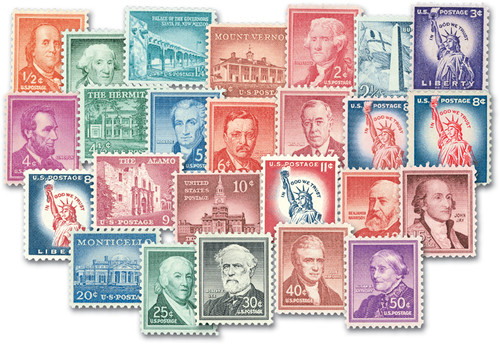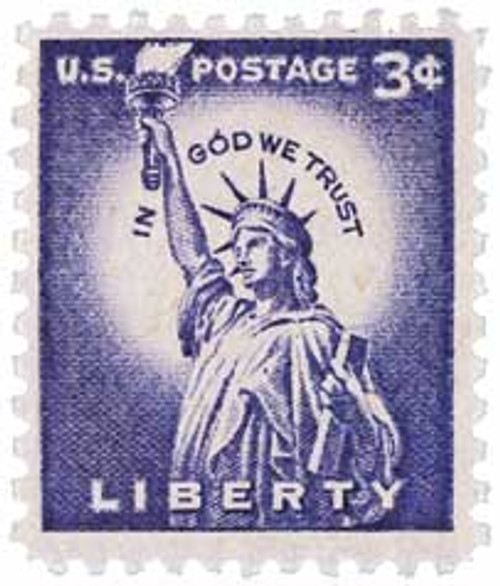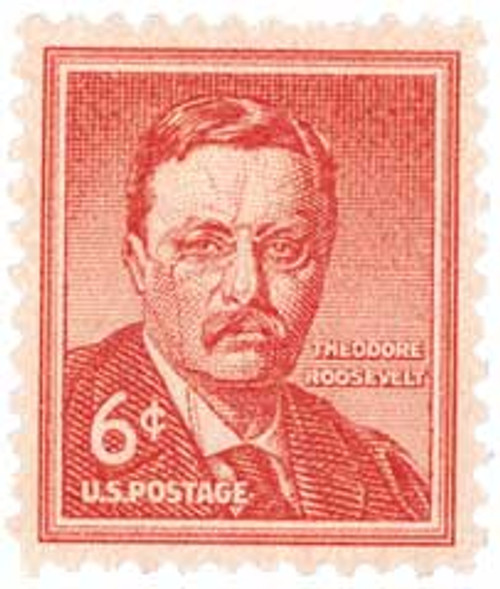
1959 Liberty Series,4 1/2¢ The Hermitage
# 1037 - 1959 Liberty Series - 4 1/2¢ The Hermitage
$0.40 - $35.00
U.S. #1037
4½¢ The Hermitage
Liberty Series
4½¢ The Hermitage
Liberty Series
Issue Date: March 16, 1959
City: Hermitage, TN
Printed by: Bureau of Engraving and Printing
Printing Method: Rotary Press
Perforations: 10½ x 11
Color: Blue green
City: Hermitage, TN
Printed by: Bureau of Engraving and Printing
Printing Method: Rotary Press
Perforations: 10½ x 11
Color: Blue green
U.S. #1037 pictures Andrew Jackson’s Home, “The Hermitage.”
The Hermitage
While practicing law, Andrew Jackson earned money by buying land and selling it to new settlers. Jackson turned a huge profit, purchasing the land for as little as 10¢ an acre and selling it for as much as $3 an acre. In 1804, he bought a large plantation 12 miles from Nashville, Tennessee, which became known as the Hermitage. During the next four decades, the Hermitage was transformed into a highly successful plantation. At the center of the estate was a beautiful Greek Revival mansion. Jackson and his wife Rachel were known for their hospitality and frequently entertained guests. Today, the Hermitage has been restored to appear as it did during Jackson’s lifetime.
The Liberty Series
Issued to replace the 1938 Presidential series, this patriotic set of stamps honors guardians of freedom throughout U.S. history. Eighteenth century America is represented by Revolutionary War heroes and statesmen such as Washington, Jefferson, Franklin, Hamilton, Henry, Jay, and Revere.
Leaders of the 19th century including Monroe, Lincoln, Lee, Harrison, and Susan B. Anthony make an appearance. The 20th century is represented by Teddy Roosevelt, Woodrow Wilson, and General Pershing.
The Liberty Series also features famous locations important to America’s democratic history, such as Bunker Hill, Independence Hall, and the Alamo.
“Wet” versus “Dry” Printing
The Bureau of Engraving and Printing began an experiment in 1954. In previous “wet” printings, the paper had a moisture content of 15 to 35 percent. In the experimental “dry” printings, the paper had a moisture content of 5 to 10 percent. This process required stiffer, thicker paper, special inks, and greater pressure to force the paper through the plates.
Stamps produced by dry printing can be distinguished by whiter paper and higher surface sheen. The stamps feel thicker and the designs are more pronounced than on wet printings. So the dry printing experiment was a success, and all U.S. postage stamps have been printed by this method since the late 1950s.
U.S. #1037
4½¢ The Hermitage
Liberty Series
4½¢ The Hermitage
Liberty Series
Issue Date: March 16, 1959
City: Hermitage, TN
Printed by: Bureau of Engraving and Printing
Printing Method: Rotary Press
Perforations: 10½ x 11
Color: Blue green
City: Hermitage, TN
Printed by: Bureau of Engraving and Printing
Printing Method: Rotary Press
Perforations: 10½ x 11
Color: Blue green
U.S. #1037 pictures Andrew Jackson’s Home, “The Hermitage.”
The Hermitage
While practicing law, Andrew Jackson earned money by buying land and selling it to new settlers. Jackson turned a huge profit, purchasing the land for as little as 10¢ an acre and selling it for as much as $3 an acre. In 1804, he bought a large plantation 12 miles from Nashville, Tennessee, which became known as the Hermitage. During the next four decades, the Hermitage was transformed into a highly successful plantation. At the center of the estate was a beautiful Greek Revival mansion. Jackson and his wife Rachel were known for their hospitality and frequently entertained guests. Today, the Hermitage has been restored to appear as it did during Jackson’s lifetime.
The Liberty Series
Issued to replace the 1938 Presidential series, this patriotic set of stamps honors guardians of freedom throughout U.S. history. Eighteenth century America is represented by Revolutionary War heroes and statesmen such as Washington, Jefferson, Franklin, Hamilton, Henry, Jay, and Revere.
Leaders of the 19th century including Monroe, Lincoln, Lee, Harrison, and Susan B. Anthony make an appearance. The 20th century is represented by Teddy Roosevelt, Woodrow Wilson, and General Pershing.
The Liberty Series also features famous locations important to America’s democratic history, such as Bunker Hill, Independence Hall, and the Alamo.
“Wet” versus “Dry” Printing
The Bureau of Engraving and Printing began an experiment in 1954. In previous “wet” printings, the paper had a moisture content of 15 to 35 percent. In the experimental “dry” printings, the paper had a moisture content of 5 to 10 percent. This process required stiffer, thicker paper, special inks, and greater pressure to force the paper through the plates.
Stamps produced by dry printing can be distinguished by whiter paper and higher surface sheen. The stamps feel thicker and the designs are more pronounced than on wet printings. So the dry printing experiment was a success, and all U.S. postage stamps have been printed by this method since the late 1950s.




















